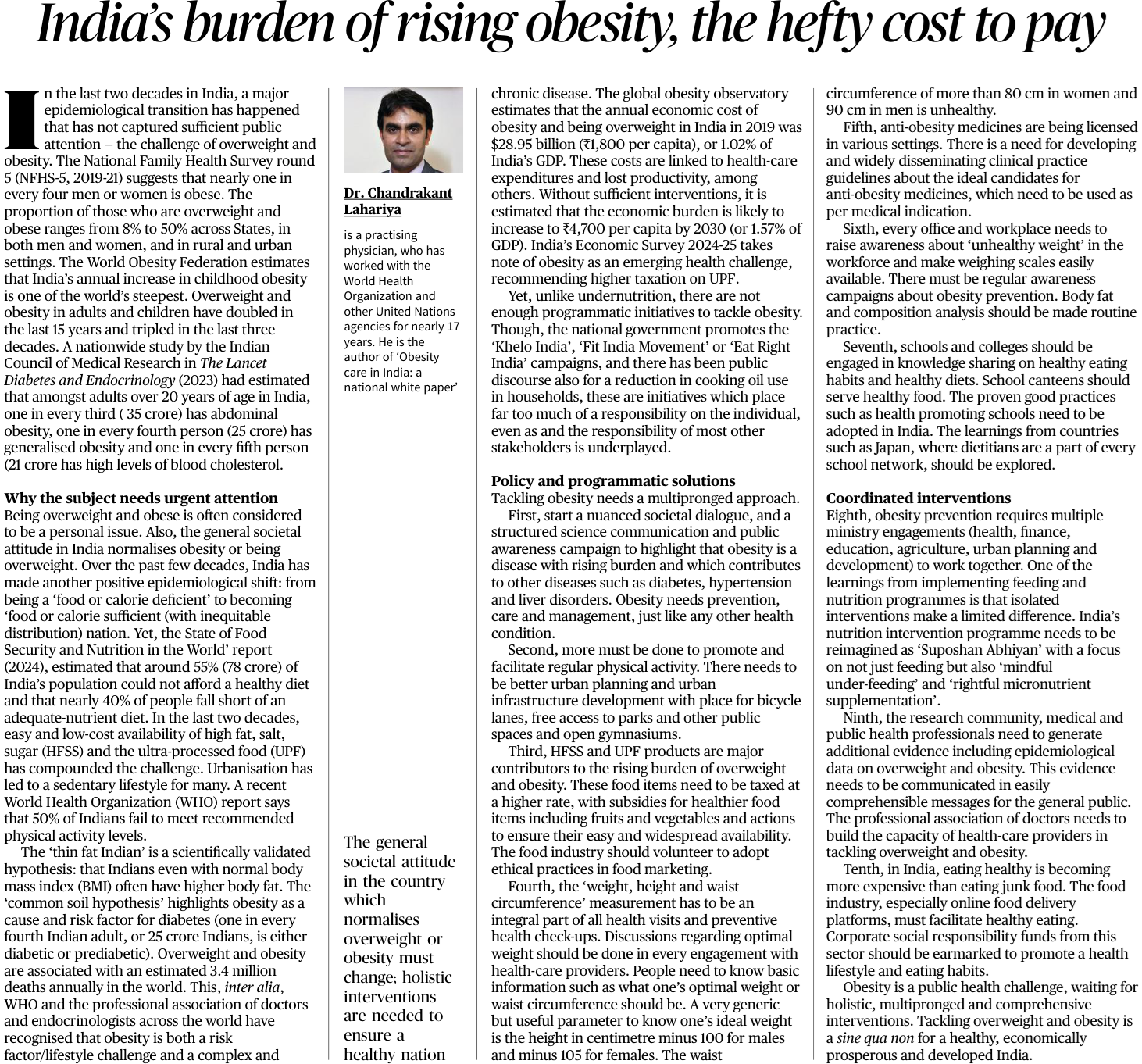1. India’s Rising Obesity Crisis: Challenges and Policy Responses
Introduction
Obesity and overweight cases in India have seen a sharp rise over the past two decades, leading to severe health, economic, and social consequences. The National Family Health Survey (NFHS-5, 2019-21) reports that nearly one in four Indians is obese. Childhood obesity, in particular, has tripled in the last three decades, making it an urgent public health concern.
Reasons for Rising Obesity in India
- Dietary Transition: Shift from a ‘calorie-deficient’ concern to ‘calorie-sufficient but imbalanced’ consumption with high fat, salt, and sugar intake.
- Urbanization & Lifestyle Changes: Increased sedentary lifestyle, reduced physical activity, and higher consumption of processed foods.
- Affordability & Accessibility: Unhealthy, processed foods are cheaper and more accessible than nutritious alternatives.
- Lack of Awareness: Social attitudes in India often normalize obesity, delaying intervention.
- Genetic & Epigenetic Factors: Some populations may have a higher genetic predisposition to obesity.
Impact of Obesity
- Health Impact: Increased risk of diabetes, hypertension, cardiovascular diseases, and other metabolic disorders.
- Economic Burden: Healthcare costs associated with obesity in India were estimated at $28.5 billion (2019), projected to rise further.
- Workforce Productivity Loss: Obesity leads to reduced efficiency and increased absenteeism.
- Impact on Children: Rising childhood obesity has long-term health implications, affecting national health outcomes.
Policy & Programmatic Interventions
- Public Awareness & Social Dialogue: National campaigns to highlight obesity as a disease and its health consequences.
- Promoting Physical Activity: Better urban planning with open spaces, parks, and improved infrastructure for exercise.
- Taxation on Ultra-Processed Foods (UPFs): Introducing sugar taxes, subsidies for healthy foods, and regulatory controls on unhealthy food advertising.
- School & Workplace Interventions: Mandatory nutrition education, healthy school canteens, and corporate wellness programs.
- Healthcare System Strengthening: Widespread anti-obesity medical interventions, training healthcare workers, and improved screening for obesity-related diseases.
- Coordinated Government Approach: Multi-sectoral efforts involving health, education, urban planning, and economic sectors.
- Research & Data Monitoring: Evidence-based policy decisions through continuous monitoring of obesity trends and intervention effectiveness.
Conclusion
India’s obesity crisis requires urgent attention due to its health and economic implications. A comprehensive and multi-sectoral approach—ranging from awareness campaigns to taxation on unhealthy foods and better urban planning—can help address the issue effectively. Policymakers must integrate obesity prevention into mainstream health and development strategies to safeguard future generations.
Bottom of FormMains Practice Question |
Q. Rising obesity levels in India pose significant health and economic challenges. Discuss the major causes, consequences, and policy measures needed to address this issue. |
2. Protecting Orans: Balancing Conservation with Community Rights
Introduction
Orans, or sacred forests, are community-managed ecosystems with ecological, cultural, and religious significance, primarily found in Rajasthan. The Supreme Court’s December 2024 judgment in T.N. Godavarman Thirumulpad v. Union of India recognized the importance of orans and passed protectionist orders. However, concerns remain over whether formalizing their governance under legal frameworks could undermine traditional community-led conservation practices.
Significance of Orans
- Ecological Importance:
- Serve as biodiversity hotspots supporting local flora and fauna.
- Enhance water availability by improving groundwater recharge.
- Cultural and Religious Role:
- Sacred spaces tied to local traditions and worship.
- Cutting trees or harming the ecosystem is often prohibited due to religious beliefs.
- Livelihood and Community Governance:
- Managed by local informal institutions.
- Support sustainable resource management, benefiting agriculture and water conservation.
Challenges of Formalizing Orans
- Declaration as Forests (Forest Conservation Act, 1980):
- Ensures legal protection but introduces exemptions (e.g., tourism, zoos, safaris) that may dilute conservation efforts.
- Communities fear losing control over their lands.
- Declaration as Community Reserves (Wildlife Protection Act, 1972):
- Requires a formal committee with limited decision-making power for locals.
- Traditional governance structures may be ignored.
- Declaration as Common Forest Land (Forest Rights Act, 2006):
- Does not necessarily empower communities unless they meet eligibility criteria.
- Informal institutions managing orans may not receive legal recognition.
The Way Forward
- Comprehensive Policy on Oran Governance:
- The Environment Ministry should develop a unified policy recognizing the diverse management approaches in different states.
- Community-Led Conservation Models:
- Instead of centralizing governance, successful informal conservation practices should be identified and replicated.
- Local communities and civil society organizations must play a key role in decision-making.
- Legal Recognition Without Bureaucratic Control:
- Policies should protect orans while ensuring that traditional management structures are not undermined.
- Rights of local communities should be legally guaranteed while avoiding excessive regulation.
Conclusion
The Supreme Court’s intent to protect orans is well-founded, but formalization may lead to unintended negative consequences. The focus should be on empowering local communities through inclusive conservation models rather than imposing rigid legal frameworks that may disrupt traditional governance systems.
Mains Practice Question |
Q. Orans (sacred forests) play a crucial role in biodiversity conservation and water management. Discuss the challenges associated with their formalization and suggest measures for their effective protection while ensuring community rights. |



